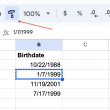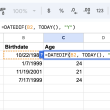A t-test is a statistical method used to compare the means of two groups and determine if there is a significant difference between them. It is commonly used in research and data analysis to assess whether the difference observed between two sample groups is due to chance or if it represents a real difference in the population. In this article, we will guide you through the steps of performing a t-test in Google Sheets, along with practical examples to help you understand the process better.
Step 1: Prepare Your Data
Before conducting a t-test, you need to have your data ready in a Google Sheets spreadsheet. Organize your data into two separate columns, one for each group you want to compare. For example, you might have a dataset of exam scores for two different study methods: Group A and Group B.
Example:
Group A: 78, 86, 72, 90, 95
Group B: 85, 80, 75, 88, 92
Step 2: Calculate the Mean and Standard Deviation
Next, you’ll need to calculate the mean and standard deviation for each group. To find the mean (average) of a dataset in Google Sheets, you can use the AVERAGE function. For instance, the formula for calculating the mean of Group A would be =AVERAGE(A2:A6).
To calculate the standard deviation in Google Sheets, use the STDEV function. For example, the formula for finding the standard deviation of Group A would be =STDEV(A2:A6).
Step 3: Perform the T-Test
Now that you have the means and standard deviations for both groups, you can proceed with the t-test. In Google Sheets, you can use the TTEST function to perform the t-test. The syntax of the function is as follows:
=TTEST(range1, range2, tails, type)
range1: The first range of data (e.g., Group A scores).range2: The second range of data (e.g., Group B scores).tails: The number of tails for the distribution (use 1 for a one-tailed test or 2 for a two-tailed test).type: The type of t-test to perform (use 1 for a paired t-test, or 2 for two-sample unequal variance t-test).
Step 4: Interpret the Results
After entering the TTEST function, Google Sheets will provide you with the results of the t-test. The output will include the t-statistic and the p-value. The t-statistic measures the difference between the means of the two groups, while the p-value indicates the probability of obtaining such results by chance alone.
- If the p-value is less than your chosen significance level (e.g., 0.05), you can reject the null hypothesis and conclude that there is a significant difference between the two groups.
Example of T-Test in Google Sheets:
Let’s use the example datasets we provided earlier to perform a t-test.
- Calculate the mean and standard deviation for both groups.
- Use the
TTESTfunction to conduct the t-test.
Step 1:
For Group A:
Mean: =AVERAGE(A2:A6) // Result: 84.2
Standard Deviation: =STDEV(A2:A6) // Result: 8.22
For Group B:
Mean: =AVERAGE(B2:B6) // Result: 84
Standard Deviation: =STDEV(B2:B6) // Result: 6.20
Step 2:
Use the TTEST function to perform the t-test:
=TTEST(A2:A6, B2:B6, 2, 2) // Two-sample unequal variance two-tailed t-test
Suppose the output shows:
t-statistic: 0.155
p-value: 0.881
Step 4:
Interpret the results: Since the p-value (0.881) is greater than the significance level (e.g., 0.05), we fail to reject the null hypothesis. Therefore, we can conclude that there is no significant difference in the exam scores between Group A and Group B.
In conclusion, Google Sheets provides a convenient way to perform t-tests for data analysis. By following the steps outlined in this article and using practical examples, you can confidently analyze and interpret the results of your t-test. This statistical method is valuable for making informed decisions and drawing meaningful conclusions from your data.






